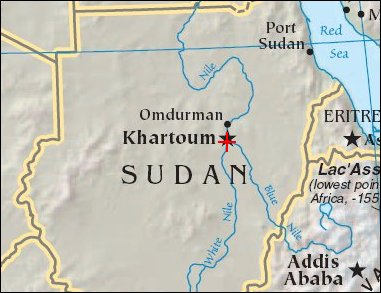| Earth from Space is a free eBook describing our planet from a satellite's perspective. Fore more information, please read the About pages. |

|

Home  Africa Africa  Sudan Sudan  Khartoum Khartoum |
|
| See also: Nile Delta, Lake Nasser | |






|
|
KhartoumPosition of center of photo (Lat/Long): [15.60352/32.52336] |
|
  Sudanís capital city, Khartoum, translates as "Elephantís Trunk". The name describes the shape of the Nile where the Blue and the White Nile Rivers unite to form the single Nile River that flows northward into Egypt. This image shows the rivers near the end of the dry season. Sudanís capital city, Khartoum, translates as "Elephantís Trunk". The name describes the shape of the Nile where the Blue and the White Nile Rivers unite to form the single Nile River that flows northward into Egypt. This image shows the rivers near the end of the dry season.
The White Nile (western branch) runs through Sudan from Uganda. The White Nile originates in equatorial regions, where rainfall occurs throughout the year; as a result, it runs at a nearly constant rate throughout the year. The Blue Nile, nearly dry this time of year, flows out of the Ethiopian highlands, where rainfall is more seasonal. The Blue Nile swells in the late summer and early fall with rains from the summer monsoons. The flow at these times can be so great that the volume is too much for the river's channel, causing the Nile to flow backward at the junction. In recent years, floods in Khartoum have occurred in August with heavy monsoon rainfall. (See more images from the Advanced Spaceborne Thermal Emission and Reflection Radiometer and Multi-angle Imaging SpectroRadiometer instruments) Khartoum is one of the largest Muslim cities in North Africa, but it has a fairly short history. Founded as a military outpost in 1821, a Sudanese flag has only flown over the city since 1956. Today, Khartoum is home to more than a million people, including many refugees, both from neighboring countries as well as from an ongoing civil war in southern Sudan. The city has a low profile, dominated by sprawling areas of small buildings that are supported by little infrastructure. |
| Source of material: NASA |
Further information: WikiPedia article on Khartoum
Last Update: 2011-03-30

